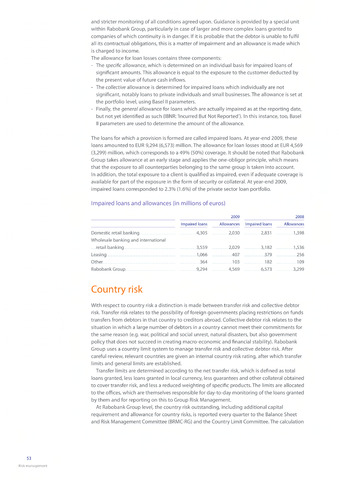Country risk
and stricter monitoring of all conditions agreed upon. Guidance is provided by a special unit
within Rabobank Group, particularly in case of larger and more complex loans granted to
companies of which continuity is in danger. If it is probable that the debtor is unable to fulfil
all its contractual obligations, this is a matter of impairment and an allowance is made which
is charged to income.
The allowance for loan losses contains three components:
- The specific allowance, which is determined on an individual basis for impaired loans of
significant amounts. This allowance is equal to the exposure to the customer deducted by
the present value of future cash inflows.
- The collective allowance is determined for impaired loans which individually are not
significant, notably loans to private individuals and small businesses. The allowance is set at
the portfolio level, using Basel II parameters.
- Finally, the general allowance for loans which are actually impaired as at the reporting date,
but not yet identified as such (IBNR: 'Incurred But Not Reported'). In this instance, too, Basel
II parameters are used to determine the amount of the allowance.
The loans for which a provision is formed are called impaired loans. At year-end 2009, these
loans amounted to EUR 9,294 (6,573) million.The allowance for loan losses stood at EUR 4,569
(3,299) million, which corresponds to a 49% (50%) coverage. It should be noted that Rabobank
Group takes allowance at an early stage and applies the one-obligor principle, which means
that the exposure to all counterparties belonging to the same group is taken into account.
In addition, the total exposure to a client is qualified as impaired, even if adequate coverage is
available for part of the exposure in the form of security or collateral. At year-end 2009,
impaired loans corresponded to 2.3% (1.6%) of the private sector loan portfolio.
Impaired loans and allowances (in millions of euros)
2009 2008
Impaired loans Allowances Impaired loans Allowances
Domestic retail banking4,305 2,030 2,83.11,398
Wholesale banking and international
retail banking3,559 2,029 3,1.82 1,536
Leasing1,066 407 379. 256.
Other36.4 103. 182 1.09.
Rabobank Group9,29.4 4,569 6,573 3,299
With respect to country risk a distinction is made between transfer risk and collective debtor
risk. Transfer risk relates to the possibility of foreign governments placing restrictions on funds
transfers from debtors in that country to creditors abroad. Collective debtor risk relates to the
situation in which a large number of debtors in a country cannot meet their commitments for
the same reason (e.g. war, political and social unrest, natural disasters, but also government
policy that does not succeed in creating macro-economic and financial stability). Rabobank
Group uses a country limit system to manage transfer risk and collective debtor risk. After
careful review, relevant countries are given an internal country risk rating, after which transfer
limits and general limits are established.
Transfer limits are determined according to the net transfer risk, which is defined as total
loans granted, less loans granted in local currency, less guarantees and other collateral obtained
to cover transfer risk, and less a reduced weighting of specific products. The limits are allocated
to the offices, which are themselves responsible for day-to-day monitoring of the loans granted
by them and for reporting on this to Group Risk Management.
At Rabobank Group level, the country risk outstanding, including additional capital
requirement and allowance for country risks, is reported every quarter to the Balance Sheet
and Risk Management Committee (BRMC-RG) and the Country Limit Committee. The calculation
53
Risk management

